|
<<
Back to The Sand Paper Index Page
|
 |
Mine Wash Pheromones
By Suzanne
Emery
This article was originally published in The Sand Paper, the membership
newsletter of the
Anza-Borrego Desert Natural History Association |
|
|
As if I needed an excuse to go
down a dirt road ...
Whether your interests are in
botany, archaeology, anthropology or clean breezes, driving a mile or so
south off Highway 78, the peace and quiet down this dirt road refreshes.
Bring along a picnic lunch to enjoy under an ironwood tree. The turnoff is
2.5 miles east of Yaqui Pass (S3)/Tamarisk Grove turn.
|
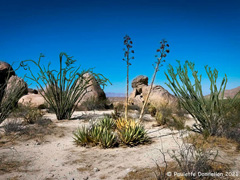 |
| |
Mine Wash |
| |
|
|
 |
Since this road’s ancient Kumeyaay village site is
recorded on every map ever printed, one cannot claim to “discover” this
little cultural interpretive area that is a full-fledged museum resource.
However, decades ago, wandering down yet another Borrego dirt road, my
late husband and I “discovered” this gem. As docents at a pre-historic
Kumeyaay village site in Poway, literally all of our accumulated
indigenous factoids, gained significance and came alive.
|
|
Pottery Bits |
|
|
|
|
| Eventually, completing our training as “certified
interpretive guides,” we earned the right/responsibility to monitor this
magical place. Husband Bob, the history buff, chronicled time immemorial,
and me, a budding student of botany, assessed plants which could be used
for food, medicine, and construction. Now all these years later, I can
tell you that recent rainy years have nurtured three dozen plants which I
can name, attracting raptor, sheep, and all manner of critter. |
 |
| |
Cholla Cactus |
| |
|
|
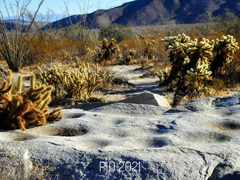 |
The interpretive sign and kiosk provide a segue from today to the past and
an invitation to meet the Kumeyaay world. Most observant visitors will
learn quite a bit just walking over four or five rolling acres past dozens
of morteros, slicks, and basins with an eye occasionally catching sight of
a sherd. When it comes to sherds, or pieces of broken ceramic pottery, or
arrow points, consider that the spirit of the person who created it,
remains with it. If you feel that you must handle it, show respect and
replace it exactly as you found it, so that the next visitor can have your
same sense of awe and excitement glimpsing into an ancient world. |
|
Morteros |
|

Arrive by 7:30 or 8 a.m. and you will be rewarded
with several hours of pleasant temperatures for imagining another eon when
visiting native families bustled about milling grass seeds for a morning
drink, stirred a pot of ground acorn mush or shawii porridge, and
gossiped. Go forward into the site, over the rolling terrain, into a
flatter area with ocotillo, agave, lavender, and chia surrounding you.
Sometimes you will find Borrego hoof prints, occasionally a jackrabbit, or
high in a cleft, a chuckwalla or a messy raptor nest. Kumeyaay seasonal
presence is documented here for the past 1,100 years at least, and again
in 1600s. Their territory extends to the coast and south to Ensenada.
|
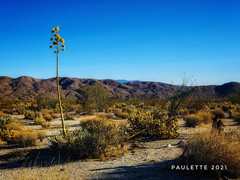 |
| |
Mine Wash |
| |
|
|
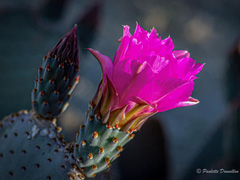 |
Storytelling, notetaking, meditation, and photography are
needed because there is so much to take in, to remember, and to respond.
And remember, a very large inland sea could be seen to the east, and
likely supplied fish. What we call the Salton Sea, also known as Lake
Cahuilla, has filled and dried up, at least six times over the past
thousand years. It was full when Juan Bautista de Anza first came through
in the 1700s.
|
|
Beavertail Cactus |
|
|
|
|
For the hardy would-be
anthropologist, some twenty acres can be explored, to gain a fuller
experience, including a bajada/delta area, a yoni, rock shelters, and (I
have been told) agave pits. Rock scramblers of all ages delight to join
their forebears anticipating discoveries of lizards, shelters, cupules,
and the magical view. While I am sure they are under a rock, I have never
seen a snake on site, and lizards are rare.
|
 |
| |
Desert Spiny Lizard |
| |
|
|
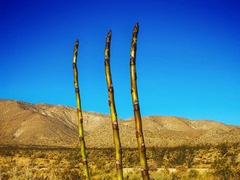 |
To appreciate all the
botany, visiting in different seasons is a must. For Summer and Fall, the
lack of plants for food explain the seasonal nature of the site. The
towering agave can provide in all seasons, but tastes better in late
spring when the root ball, like a giant artichoke heart, is roasted in a
giant pit. Think apple pie texture and flavor, without cinnamon and
nutmeg, or the crust. I love the caramelized edges. At all times of the
year, agave leaves provide fiber for twine and rope-making for pack nets
and traps. The variety of plants speaks to many medicinal uses, as well as
colorful blossoms for pigment in basketry and tattoos.
|
|
Agave Stalks |
|
|
|
|
When all is
said and done, and you’ve have come back to town for a late breakfast,
head over to the Visitor Center at the State Park. In addition to air
conditioning, the building holds two must see exhibits: a replica Kumeyaay
rock shelter with recorded “bird songs,” and -- opposite the large diorama
of wildlife -- a complete exhibit of the archeological digs that have been
conducted at Mine Wash. Best of all is a floor-to-ceiling, corner-shaped,
acrylic case labeled by metric depth, with the items uncovered from each
millennium at Mine Wash. If you did not get goose bumps out at the
village, this display will do it.
|
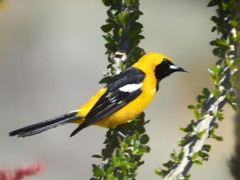 |
| |
Hooded Oriole |
| |
|
|
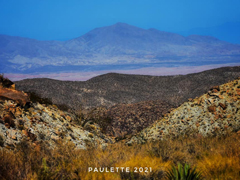 |
There’s a reason the name is
Mine WASH. In the Spring, wait a few weeks after the rains to let the
hardcore types tamp down the mounds of run-off sand, which each year,
inevitably reshape the dirt road to the village site and beyond. There is
an end of the road several miles up the canyon, with a turn around. Hiking
a bit further up from the turnaround, gives the vista of “the other side,”
Earthquake Valley, and even more flowers and plants to identify. It is not
clear what mineral was mined up there, but likely was a WWII item.
|
|
View from Mine Wash |
|
|
|
|
When you go: The family SUV and many sedans with high
clearance usually do fine; folks in low to the ground vehicles should
carpool in other cars. Bring hats, water, sturdy shoes, and sun screen. Do
not let your car tires drop off the hard-packed road, or you will need to
use those carpet samples you keep in the trunk, along with a small shovel.
Hiking out to Highway 78 does not guarantee that one of the 70 MPH
vehicles will stop to pick you up.
|
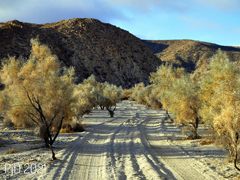 |
| |
Smoke Tree Alley |
| |
|
|
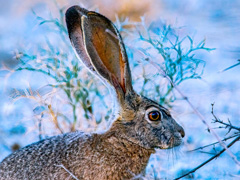 |
Please be respectful of the
site’s cultural significance; no collecting is allowed. Do not pitch tents
or build fires in the area. A pit toilet is located about half way in from
the highway. Four-legged companions need to stay in town, and wheeled
vehicles including bicycles, and drones, are not welcome. There is no cell
signal; putting your phone in “airplane mode” will conserve power so you
can still take pictures and record waypoints.
|
|
Jackrabbit |
|
|
|
|
|
All photos were taken in Mine Wash by Paulette Donnellon. |
Directions
-
From the Tamarisk
Grove intersection at Highway 78 and S-3, drive east on Highway 78 for 2.7
miles.
-
Turn right (south) onto
the jeep road for Mine Wash.
-
Hike or drive on the
jeep road toward the south for 1.6 miles to the Mine Wash Indian Village
Site.
-
An interpretative sign
near an ironwood tree describes the old Indian Village Site.
-
4WD is recommended due
to soft sand and rocks.
Suzanne Emery was the
Archaeological Site Steward for Mine Wash and a long-time
ADBNHA volunteer. She was also an educator as well as an avid photographer
and bird-watcher. She passed away in October 2020.
© Anza-Borrego Desert
Natural History Association (ABDNHA), The Sand Paper, Early Spring 2020.
|